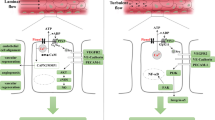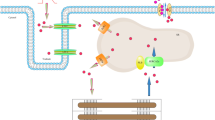Abstract
Zinc exists in biological systems as bound and histochemically reactive free Zn2+ in the nanomolar range. Zinc is required as either structural or catalytic component for a large number of enzymes. It also modulates current passage through many ion channels. Here, we reinvestigated the effects of extracellular and intracellular Zn2+ on the L-type Ca2+ current (I CaL) and its modulation by β-adrenergic stimulation in rat ventricular cardiomyocytes. In the absence of Ca2+ ions, Zn2+ could permeate through the L-type channel at much lower concentrations and at a more positive voltage range, but with a lower permeability than Ca2+. In the presence of Ca2+, extracellular Zn2+ demonstrated strong bimodal inhibitory effects on the I CaL, with half-inhibition occurring around 30 nM, i.e., in the range of concentrations found in the plasma. Intracellular Zn2+ also significantly inhibited the I CaL with a half-inhibitory effect at 12.7 nM. Moreover, β-adrenergic stimulation was markedly reduced by intracellular Zn2+ at even lower concentrations (<1 nM) as a consequence of Zn2+-induced inhibition of the adenylyl cyclase. All these effects appeared independent of redox variations and were not affected by dithiothreitol. Thus, both basal intracellular and extracellular Zn2+ modulate transmembrane Ca2+ movements and their regulation by β-adrenergic stimulation. Considering that, in many pathological situations, including diabetes, the extracellular Zn2+ concentration is reduced and the intracellular one is increased, our results help to explain both Ca2+ overload and marked reduction in the β-adrenergic stimulation in these diseases.





Similar content being viewed by others
References
Alvarez JL, Artiles A, Talavera K, Vassort G (2000) Modulation of voltage-dependent facilitation of the T-type calcium current by sodium ion in isolated frog atrial cells. Pflügers Arch 441:39–48
Andersson DC, Fauconnier J, Yamada T, Lacampagne A, Zhang SJ, Katz A, Westerblad H (2011) Mitochondrial production of reactive oxygen species contributes to the beta-adrenergic stimulation of mouse cardiomyocytes. J Physiol 589:1791–1801
Ando M, Oku N, Takeda A (2010) Zinc-mediated attenuation of hippocampal mossy fiber long-term potentiation induced by forskolin. Neurochem Int 57:608–614
Aras MA, Saadi RA, Aizenman E (2009) Zn2+ regulates Kv2.1 voltage-dependent gating and localization following ischemia. Eur J Neurosci 30:2250–2257
Ascher P, Nowak L (1988) The role of divalent cations in the N-methyl-d-aspartate responses of mouse central neurones in culture. J Physiol 399:247–266
Atar D, Backx PH, Appel MM, Gao WD, Marban E (1995) Excitation–transcription coupling mediated by zinc influx through voltage-dependent calcium channels. J Biol Chem 270:2473–2477
Ayaz M, Turan B (2006) Selenium prevents diabetes-induced alterations in [Zn2+]i and metallothionein level of rat heart via restoration of cell redox cycle. Am J Physiol Heart Circ Physiol 290:H1071–H1080
Baltas LG, Karczewski P, Krause EG (1997) Effects of zinc on phospholamban phosphorylation. Biochem Biophys Res Commun 232:394–397
Beyersmann D, Haase H (2001) Functions of zinc in signaling, proliferation and differentiation of mammalian cells. Biometals 14:331–341
Bilginoglu A, Seymen A, Tuncay E, Zeydanli E, Aydemir-Koksoy A, Turan B (2009) Antioxidants but not doxycycline treatments restore depressed beta-adrenergic responses of the heart in diabetic rats. Cardiovasc Toxicol 9:21–29
Brennan JP, Bardswell SC, Burgoyne JR, Fuller W, Schroder E, Wait R, Begum S, Kentish JC, Eaton P (2006) Oxidant-induced activation of type I protein kinase A is mediated by RI subunit interprotein disulfide bond formation. J Biol Chem 281:21827–21836
Brumas V, Hacht B, Filella M, Berthon G (1992) Can N-acetyl-l-cysteine affect zinc metabolism when used as a paracetamol antidote? Agents Actions 36:278–288
Choi YB, Lipton SA (1999) Identification and mechanism of action of two histidine residues underlying high-affinity Zn2+ inhibition of the NMDA receptor. Neuron 23:171–180
Chu XP, Wemmie JA, Wang WZ, Zhu XM, Saugstad JA, Price MP, Simon RP, Xiong ZG (2004) Subunit-dependent high-affinity zinc inhibition of acid-sensing ion channels. J Neurosci 24:8678–8689
Dineley KE, Richards LL, Votyakova TV, Reynolds IJ (2005) Zinc causes loss of membrane potential and elevates reactive oxygen species in rat brain mitochondria. Mitochondrion 5:55–65
Fayyazuddin A, Villarroel A, Le Goff A, Lerma J, Neyton J (2000) Four residues of the extracellular N-terminal domain of the NR2A subunit control high-affinity Zn2+ binding to NMDA receptors. Neuron 25:683–694
Fukuda J, Kawa K (1977) Permeation of manganese, cadmium, zinc, and beryllium through calcium channels of an insect muscle membrane. Science 196:309–311
Gando S, Hattori Y, Akaishi Y, Nishihira J, Kanno M (1997) Impaired contractile response to beta adrenoceptor stimulation in diabetic rat hearts: alterations in beta adrenoceptors-G protein-adenylate cyclase system and phospholamban phosphorylation. J Pharmacol Exp Ther 282:475–484
Gao X, Du Z, Patel TB (2005) Copper and zinc inhibit GalphaS function: a nucleotide-free state of GalphaS induced by Cu2+ and Zn2+. J Biol Chem 280:2579–2586
Gilly WF, Armstrong CM (1982) Divalent cations and the activation kinetics of potassium channels in squid giant axons. J Gen Physiol 79:965–996
Gilly WF, Armstrong CM (1982) Slowing of sodium channel opening kinetics in squid axon by extracellular zinc. J Gen Physiol 79:935–964
Gómez AM, Kerfant BG, Vassort G (2000) Microtubule disruption modulates Ca2+ signaling in rat cardiac myocytes. Circ Res 86:30–36
Haase H, Maret W (2003) Intracellular zinc fluctuations modulate protein tyrosine phosphatase activity in insulin/insulin-like growth factor-1 signaling. Exp Cell Res 291:289–298
Hamill OP, Marty A, Neher E, Sakmann B, Sigworth FJ (1981) Improved patch-clamp techniques for high-resolution current recording from cells and cell-free membrane patches. Pflugers Arch 391:85–100
Hool LC (2009) The L-type Ca2+ channel as a potential mediator of pathology during alterations in cellular redox state. Heart Lung Circ 18:3–10
Hool LC, Arthur PG (2002) Decreasing cellular hydrogen peroxide with catalase mimics the effects of hypoxia on the sensitivity of the L-type Ca2+ channel to beta-adrenergic receptor stimulation in cardiac myocytes. Circ Res 91:601–609
Jansen J, Rosenkranz E, Overbeck S, Warmuth S, Mocchegiani E, Giacconi R, Weiskirchen R, Karges W, Rink L (2012) Disturbed zinc homeostasis in diabetic patients by in vitro and in vivo analysis of insulinomimetic activity of zinc. J Nutr Biochem. Available at http://www.sciencedirect.com/science/article/pii/S0955286311002750
Kamalov G, Deshmukh PA, Baburyan NY, Gandhi MS, Johnson PL, Ahokas RA, Bhattacharya SK, Sun Y, Gerling IC, Weber KT (2009) Coupled calcium and zinc dyshomeostasis and oxidative stress in cardiac myocytes and mitochondria of rats with chronic aldosteronism. J Cardiovasc Pharmacol 53:414–423
Kamp TJ, Hell JW (2000) Regulation of cardiac L-type calcium channels by protein kinase A and protein kinase C. Circ Res 87:1095–1102
Kawa K (1979) Zinc-dependent action potentials in giant neurons of the snail, Euhadra quaestia. J Membr Biol 49:325–344
Keef KD, Hume JR, Zhong J (2001) Regulation of cardiac and smooth muscle Ca2+ channels (CaV1.2a, b) by protein kinases. Am J Physiol Cell Physiol 281:C1743–C1756
Kerchner GA, Canzoniero LM, Yu SP, Ling C, Choi DW (2000) Zn2+ current is mediated by voltage-gated Ca2+ channels and enhanced by extracellular acidity in mouse cortical neurones. J Physiol 528(Pt 1):39–52
Klein C, Sunahara RK, Hudson TY, Heyduk T, Howlett AC (2002) Zinc inhibition of cAMP signaling. J Biol Chem 277:11859–11865
Krezyel A, Maret W (2006) Zinc buffering capacity of a eukaryotic cell at physiological pZn. J Biol Inorg Chem 11:1049–1062
Korichneva I, Hoyos B, Chua R, Levi E, Hammerling U (2002) Zinc release from protein kinase C as the common event during activation by lipid second messenger or reactive oxygen. J Biol Chem 277:44327–44331
Maret W (2005) Zinc coordination environments in proteins determine zinc functions. J Trace Elem Med Biol 19:7–12
Maret W (2009) Molecular aspects of human cellular zinc homeostasis: redox control of zinc potentials and zinc signals. Biometals 22:149–157
Noh KM, Kim YH, Koh JY (1999) Mediation by membrane protein kinase C of zinc-induced oxidative neuronal injury in mouse cortical cultures. J Neurochem 72:1609–1616
Paoletti P, Ascher P, Neyton J (1997) High-affinity zinc inhibition of NMDA NR1-NR2A receptors. J Neurosci 17:5711–5725
Puceat M, Bony C, Jaconi M, Vassort G (1998) Specific activation of adenylyl cyclase V by a purinergic agonist. FEBS Lett 431:189–194
Sekler I, Sensi SL, Hershfinkel M, Silverman WF (2007) Mechanism and regulation of cellular zinc transport. Mol Med 13:337–343
Sims C, Harvey RD (2004) Redox modulation of basal and beta-adrenergically stimulated cardiac L-type Ca2+ channel activity by phenylarsine oxide. Br J Pharmacol 142:797–807
Spires S, Begenisich T (1995) Voltage-independent gating transitions in squid axon potassium channels. Biophys J 68:491–500
Tabata T, Ishida AT (1999) A zinc-dependent Cl− current in neuronal somata. J Neurosci 19:5195–5204
Tamada A, Hattori Y, Houzen H, Yamada Y, Sakuma I, Kitabatake A, Kanno M (1998) Effects of beta-adrenoceptor stimulation on contractility, [Ca2+]i, and Ca2+ current in diabetic rat cardiomyocytes. Am J Physiol 274:H1849–H1857
Taylor KM, Hiscox S, Nicholson RI, Hogstrand C, Kille P (2012) Protein kinase CK2 triggers cytosolic zinc signaling pathways by phosphorylation of zinc channel ZIP7. Sci Signal 5(210):ra11
Terrés-Martos C, Navarro-Alarcón M, Martín-Lagos F, López-García de la Serrana H, Pérez-Valero V, López-Martínez MC (1998) Serum zinc and copper concentrations and Cu/Zn ratios in patients with hepatopathies or diabetes. J Trace Elem Med Biol 12:44–49
Traboulsie A, Chemin J, Chevalier M, Quignard JF, Nargeot J, Lory P (2007) Subunit-specific modulation of T-type calcium channels by zinc. J Physiol 578:159–171
Traynelis SF, Burgess MF, Zheng F, Lyuboslavsky P, Powers JL (1998) Control of voltage-independent zinc inhibition of NMDA receptors by the NR1 subunit. J Neurosci 18:6163–6175
Tuncay E, Bilginoglu A, Sozmen NN, Zeydanli EN, Ugur M, Vassort G, Turan B (2011) Intracellular free zinc during cardiac excitation-contraction cycle: calcium and redox dependencies. Cardiovasc Res 89:634–642
Turan B (2003) Zinc-induced changes in ionic currents of cardiomyocytes. Biol Trace Elem Res 94:49–60
Turan B, Fliss H, Desilets M (1997) Oxidants increase intracellular free Zn2+ concentration in rabbit ventricular myocytes. Am J Physiol 272:H2095–H2106
Vallee BL, Falchuk KH (1993) The biochemical basis of zinc physiology. Physiol Rev 73:79–118
van der Heyden MA, Wijnhoven TJ, Opthof T (2005) Molecular aspects of adrenergic modulation of cardiac L-type Ca2+ channels. Cardiovasc Res 65:28–39
Viola HM, Arthur PG, Hool LC (2007) Transient exposure to hydrogen peroxide causes an increase in mitochondria-derived superoxide as a result of sustained alteration in L-type Ca2+ channel function in the absence of apoptosis in ventricular myocytes. Circ Res 100:1036–1044
von Bulow V, Rink L, Haase H (2005) Zinc-mediated inhibition of cyclic nucleotide phosphodiesterase activity and expression suppresses TNF-alpha and IL-1 beta production in monocytes by elevation of guanosine 3′,5′-cyclic monophosphate. J Immunol 175:4697–4705
Wilson M, Hogstrand C, Maret W (2012) Picomolar concentrations of free zinc (II) ions regulate receptor protein-tyrosine phosphatase β activity. J Biol Chem 12:9322–9326
Yatani A, Goto M (1983) The effect of extracellular low pH on the plateau current in isolated, single rat ventricular cells: a voltage clamp study. Jpn J Physiol 33:403–415
Zhang S, Kehl SJ, Fedida D (2001) Modulation of Kv1.5 potassium channel gating by extracellular zinc. Biophys J 81:125–136
Author information
Authors and Affiliations
Corresponding author
Rights and permissions
About this article
Cite this article
Alvarez-Collazo, J., Díaz-García, C.M., López-Medina, A.I. et al. Zinc modulation of basal and β-adrenergically stimulated L-type Ca2+ current in rat ventricular cardiomyocytes: consequences in cardiac diseases. Pflugers Arch - Eur J Physiol 464, 459–470 (2012). https://doi.org/10.1007/s00424-012-1162-3
Received:
Revised:
Accepted:
Published:
Issue Date:
DOI: https://doi.org/10.1007/s00424-012-1162-3




